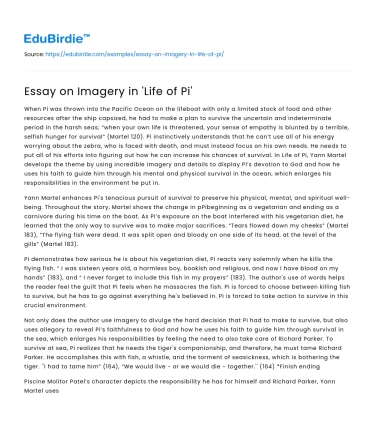When Pi was thrown into the Pacific Ocean on the lifeboat with only a limited stock of food and other resources after the ship capsized, he had to make a plan to survive the uncertain and indeterminate period in the harsh seas; “when your own life is threatened, your sense of empathy is blunted by a terrible, selfish hunger for survival” (Martel 120). Pi instinctively understands that he can’t use all of his energy worrying about the zebra, who is faced with death, and must instead focus on his own needs. He needs to put all of his efforts into figuring out how he can increase his chances of survival. In Life of Pi, Yann Martel develops the theme by using incredible imagery and details to display Pi’s devotion to God and how he uses his faith to guide him through his mental and physical survival in the ocean, which enlarges his responsibilities in the environment he put in.
Yann Martel enhances Pi's tenacious pursuit of survival to preserve his physical, mental, and spiritual well-being. Throughout the story, Martel shows the change in pPibeginning as a vegetarian and ending as a carnivore during his time on the boat. As Pi’s exposure on the boat interfered with his vegetarian diet, he learned that the only way to survive was to make major sacrifices. “Tears flowed down my cheeks” (Martel 183), “The flying fish were dead. It was split open and bloody on one side of its head, at the level of the gills” (Martel 183).
Save your time!
We can take care of your essay
- Proper editing and formatting
- Free revision, title page, and bibliography
- Flexible prices and money-back guarantee
Pi demonstrates how serious he is about his vegetarian diet, Pi reacts very solemnly when he kills the flying fish. “ I was sixteen years old, a harmless boy, bookish and religious, and now I have blood on my hands” (183), and “ I never forget to include this fish in my prayers” (183). The author's use of words helps the reader feel the guilt that Pi feels when he massacres the fish. Pi is forced to choose between killing fish to survive, but he has to go against everything he's believed in. Pi is forced to take action to survive in this crucial environment.
Not only does the author use imagery to divulge the hard decision that Pi had to make to survive, but also uses allegory to reveal Pi’s faithfulness to God and how he uses his faith to guide him through survival in the sea, which enlarges his responsibilities by feeling the need to also take care of Richard Parker. To survive at sea, Pi realizes that he needs the tiger's companionship, and therefore, he must tame Richard Parker. He accomplishes this with fish, a whistle, and the torment of seasickness, which is bothering the tiger. ''I had to tame him” (164), “We would live - or we would die - together.'' (164) *Finish ending
Piscine Molitor Patel’s character depicts the responsibility he has for himself and Richard Parker, Yann Martel uses specific details and imagery to accentuate these qualities as Pi…






 Stuck on your essay?
Stuck on your essay?

